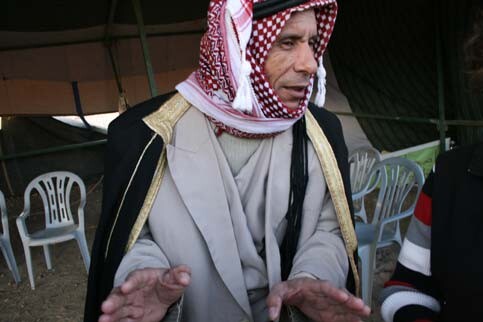IRIN 20 January 2007

Aqil Talalka says Israel does not recognise his tribe’s ownership of land. (Tom Spender/IRIN)
TWAIL ABU JARWAL, 18 Jan 2007 - In the Negev Desert village of Twail Abu Jarwal, a Bedouin boy is hammering away at the roof of a new tin shack in the setting sun. Around him are the twisted ruins of the Talalka tribe’s 22 homes and a few animal shacks.
The Israeli authorities on 9 January demolished them for the second time in just over a month because Twail Abu Jarwal is among 34 Bedouin villages that officially do not exist, according to the Israeli government. Israeli officials say all homes are illegal because they were built without a permit.
“They came at 5 a.m. with police, a helicopter and bulldozers and just demolished everything,” said village chief Aqil Talalka. “Now we are rebuilding because we have nowhere else to go.”
About 150,000 Bedouin Arabs live in the Negev Desert in southern Israel and face discrimination over the provision of essential services, local aid workers say. Their claims to land ownership have been turned down by successive Israeli governments and those who do not live in government-approved new towns face having their homes demolished.
Aqil said he had little hope that Israel’s attitude to the Bedouin’s land claim would change. “Israel will only recognise my ownership of the land if I agree to sell it to them. Then they are only too happy to recognise it. Otherwise, I have no rights,” he said.
“We believe the Bedouin should be treated as an indigenous people and should be given their rights,” said Yeela Ranaan of the Regional Council of Unrecognised Villages (RCUV).
“But the government is running a powerful campaign against them through the media, describing them as squatters and land-grabbers taking Jewish land. It’s easy because the Bedouin are Arabs and, therefore, in theory belong to Israel’s enemies,” said Ranaan.
Today’s Bedouin are descended from about 10,000 who remained in the Negev during the war of 1948; 80,000 fled to Jordan, refugee camps in Gaza and the West Bank and mixed Israeli cities farther north such as Ramle or Lod, Ranaan said.
The remaining communities were moved into the Siyag or Enclosed Zone, in the northeast of the Negev, with much of the rest of the region being declared state land.
Successive Israeli governments have tried to get people such as the Talalkas to abandon claims to land ownership and settle in one of seven towns built to house them. They are offered cheap plots of land for a house and access to electricity, water, health and education.
“The idea was to get as many Arabs on as little land as possible,” said Ranaan.
Unrecognised villages
But despite Israel’s efforts, only about half the Bedouin have moved into the towns. The remaining 80,000 are still in unrecognised villages in the Siyag Zone, without access to water and electricity supplies and sewage facilities.
Under a government proposal in 1976, the 500-strong Talalka group had accepted and paid for land near the wealthy Beer Sheva suburb of Lagia, Aqil said. But after a 30-year wait, the land had still not been made available - so the Talalkas returned to the hillsides they say their tribe has lived on for centuries.
“We were living on land owned by another tribe. It was overcrowded and some of us were asked to leave because the other tribe had grown and needed the extra land for itself,” said Aqil.
The authorities’ response was harsh - buildings in Twail Abu Jarwal have been destroyed four times in recent months.
“The law is the same for everyone. There would be no difference if it was a town mayor who builds illegally or a Bedouin,” Sabine Haddan, spokeswoman for Israel’s Ministry of the Interior, said.
However, the Talalkas have not moved. They are sheltering in tents and organisations such as the RCUV and the Israeli Committee Against House Demolitions are helping them to rebuild.
They are encouraged by the fact that nine villages inhabited by about 30,000 Bedouin have been or are in the process of being recognised, according to the RCUV.
“But the government is still refusing to acknowledge traditional ownership of the land. And if the government recognises a village, it wants to make orders preventing the residents from working the land around it,” said Ramaan.
Successive Israeli governments passed laws to discourage Bedouin agriculture, such as the so-called Black Goat law in 1950, which specifically prohibited anyone from raising flocks of black goats. This affected the Bedouin because they used to keep flocks of black goats and would use the hair to make tents.
Related Links’